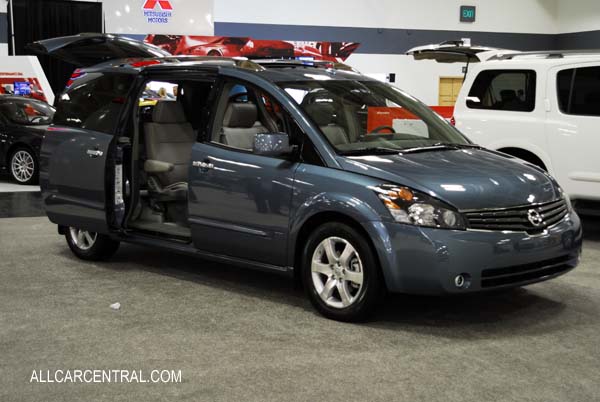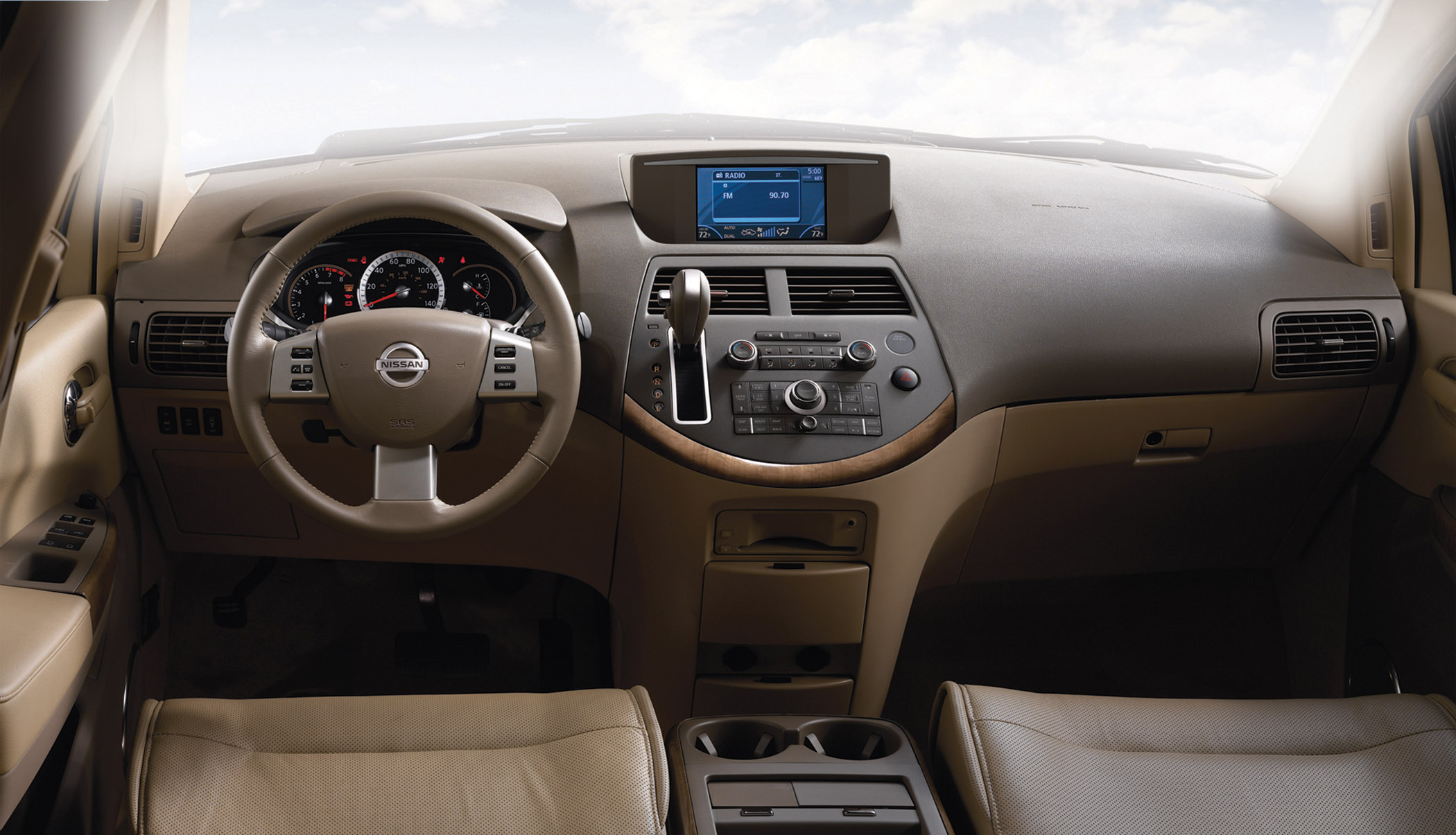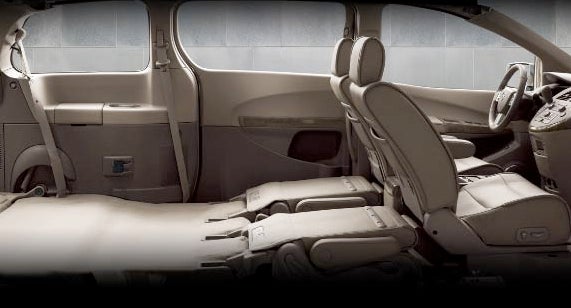Both vehicles were initially powered by the 3.0 L Nissan VG30E V6 until 1999, when the Quest received the 3.3 L version of the same engine and a few minor updates, including a driver side sliding door, and grill and rear redesigns. The Quest was later completely redesigned for 2004, while the Villager was discontinued and replaced with the Freestar-based Mercury Monterey. The third generation model was built on the FF-L platform, which it shares with the Altima, Maxima, and Murano. It also shares the award-winning 3.5 L VQ engine with those cars. The fourth generation model is built on the same platform as the 2011 Nissan Elgrand.

2009 Nissan Quest Image

2009 Nissan Quest
The Nissan Quest was a new model made by Nissan to compete in the minivan segment. The Quest was a successor to the Axxess, which was sold in the United States in 1990 only and in Canada from 1990-1995. It also replaced the rear-wheel drive Vanette, also discontinued in 1990. The Quest was initially powered by Nissan's 3.0 L VG30E SOHC engine that made 151 hp (113 kW) and 182 lb·ft (247 N·m). Ford required that Nissan make some design changes to the VG30E before they would agree to use it in the Villager and Quest. One of the requirements from Ford was that the engine was to be modified to become a non-interference or free-running engine. (Thus if the timing belt breaks, there would be no damage to the valves). Other changes included the addition of an oil level sensor and relocating the oil filter assembly for better access. The Quest was available as XE or GXE models. Because of manufacturing issues, Nissan had an arrangement for Ford to assemble the minivan in North America, and in turn they were allowed to rebadge it and sell it under the Mercury brand as the Villager. Many of the interior parts, including the radio, heater controls and power windows controls were adapted from Ford, and were similar to the Ford Aerostar. This generation of the Quest and Villager was built at Ford's Ohio Assembly plant in Avon Lake, Ohio. The van shared the modified version of the VG30E from the U11, and early J30 Maximas, as well as the 4-speed automatic transmission from the Maxima. The Quest/Villager engine seems to have a serious flaw in the crankshaft, as they break at the front stub. Nissan increased the diameter from 25 to 27 mm around 1995. The Quest is distinguishable from the Mercury Villager by a different grille, side trim, front and rear bumpers, and tail lights.

2009 Nissan Quest 3.5 S
Seating was for 7, with a removable 2-seater bench in the middle, allowing the third row bench of 3 seats to slide up (either folded up for more room or down for passengers) behind the front for more rear cargo room. 1994 the first year for the driver's side airbag, with a passenger airbag added in 1996. That year saw the introduction of changes to the front and rear fascias, as well as headlights and tail lamps and the elimination of the motorized shoulder belts.

2009 Nissan Quest image
The headlamp assembly for 1996-1998 Quests will fit into 1993-1995 Quests. The only modification required is to the switch the low-beam (center pin) and ground pins on the light bulb socket. The newer assembly will also use the brighter 9007 bulb with ~1000 lumens vs ~700 of the 9004 bulb.

Nissan Quest 2009

2009 Nissan Quest Image
For 1999, the Quest was redesigned, and it gave the exterior a more aerodynamic look, and the driver's side sliding door. The Quest also got a power boost via the 3.3 L VG33E SOHC engine, making 171 hp (128 kW) and 200 lb·ft (270 N·m) of torque. The XE trim was discontinued and the GXE was moved as the base model. Two new trim levels were also introduced: the top of the line GLE and the sport model SE. This Nissan Quest model became the first Nissan minivan with 4 doors since the 1995 Nissan Axxess.

2009-Nissan-Quest-2

2009 Nissan Quest

2009 Nissan Quest Images
The 2001 Quest received various minor improvements. Styling front and rear was updated, along with new alloy wheels on all models. The entry-level GXE gained a rear stabilizer bar, while the SE received acceleration-sensitive strut valving and a strut tower brace. New interior gauges and fabrics as well as a 130-watt sound system were standard on SE and GLE. Luxury GLE models also received an in-dash six-CD changer and a wood and leather-trimmed steering wheel. An optional overhead family entertainment system replaced the former floor-mounted model, though it could still be specified for SEs and GLEs equipped with a sunroof. Front seatbelts were given pretensioners. The 2001 Quest was also slightly longer, with more cargo space than the previous generation. The 2002 Nissan Quest was not sold in Canada. The Quest would not return to Canada until the third generation model arrived in 2004.

Nissan Quest 2009 Picture

Nissan Quest Cargo Organizer
By the end of this generation, both Honda and Toyota marketed solely long-wheelbase minivans. No Quest models were marketed for the 2003 model year.

cube i perfur Nissan quest

Nissan Quest 2004

Edmunds.com 2009 Nissan Quest

2009 Nissan Quest

2009 Nissan Quest Image

2009 Nissan Quest Image

2009 Nissan Quest
The Nissan Quest was a new model made by Nissan to compete in the minivan segment. The Quest was a successor to the Axxess, which was sold in the United States in 1990 only and in Canada from 1990-1995. It also replaced the rear-wheel drive Vanette, also discontinued in 1990. The Quest was initially powered by Nissan's 3.0 L VG30E SOHC engine that made 151 hp (113 kW) and 182 lb·ft (247 N·m). Ford required that Nissan make some design changes to the VG30E before they would agree to use it in the Villager and Quest. One of the requirements from Ford was that the engine was to be modified to become a non-interference or free-running engine. (Thus if the timing belt breaks, there would be no damage to the valves). Other changes included the addition of an oil level sensor and relocating the oil filter assembly for better access. The Quest was available as XE or GXE models. Because of manufacturing issues, Nissan had an arrangement for Ford to assemble the minivan in North America, and in turn they were allowed to rebadge it and sell it under the Mercury brand as the Villager. Many of the interior parts, including the radio, heater controls and power windows controls were adapted from Ford, and were similar to the Ford Aerostar. This generation of the Quest and Villager was built at Ford's Ohio Assembly plant in Avon Lake, Ohio. The van shared the modified version of the VG30E from the U11, and early J30 Maximas, as well as the 4-speed automatic transmission from the Maxima. The Quest/Villager engine seems to have a serious flaw in the crankshaft, as they break at the front stub. Nissan increased the diameter from 25 to 27 mm around 1995. The Quest is distinguishable from the Mercury Villager by a different grille, side trim, front and rear bumpers, and tail lights.

2009 Nissan Quest 3.5 S
Seating was for 7, with a removable 2-seater bench in the middle, allowing the third row bench of 3 seats to slide up (either folded up for more room or down for passengers) behind the front for more rear cargo room. 1994 the first year for the driver's side airbag, with a passenger airbag added in 1996. That year saw the introduction of changes to the front and rear fascias, as well as headlights and tail lamps and the elimination of the motorized shoulder belts.

2009 Nissan Quest image
The headlamp assembly for 1996-1998 Quests will fit into 1993-1995 Quests. The only modification required is to the switch the low-beam (center pin) and ground pins on the light bulb socket. The newer assembly will also use the brighter 9007 bulb with ~1000 lumens vs ~700 of the 9004 bulb.

Nissan Quest 2009

2009 Nissan Quest Image
For 1999, the Quest was redesigned, and it gave the exterior a more aerodynamic look, and the driver's side sliding door. The Quest also got a power boost via the 3.3 L VG33E SOHC engine, making 171 hp (128 kW) and 200 lb·ft (270 N·m) of torque. The XE trim was discontinued and the GXE was moved as the base model. Two new trim levels were also introduced: the top of the line GLE and the sport model SE. This Nissan Quest model became the first Nissan minivan with 4 doors since the 1995 Nissan Axxess.

2009-Nissan-Quest-2

2009 Nissan Quest

2009 Nissan Quest Images
The 2001 Quest received various minor improvements. Styling front and rear was updated, along with new alloy wheels on all models. The entry-level GXE gained a rear stabilizer bar, while the SE received acceleration-sensitive strut valving and a strut tower brace. New interior gauges and fabrics as well as a 130-watt sound system were standard on SE and GLE. Luxury GLE models also received an in-dash six-CD changer and a wood and leather-trimmed steering wheel. An optional overhead family entertainment system replaced the former floor-mounted model, though it could still be specified for SEs and GLEs equipped with a sunroof. Front seatbelts were given pretensioners. The 2001 Quest was also slightly longer, with more cargo space than the previous generation. The 2002 Nissan Quest was not sold in Canada. The Quest would not return to Canada until the third generation model arrived in 2004.

Nissan Quest 2009 Picture

Nissan Quest Cargo Organizer
By the end of this generation, both Honda and Toyota marketed solely long-wheelbase minivans. No Quest models were marketed for the 2003 model year.

cube i perfur Nissan quest

Nissan Quest 2004
Edmunds.com 2009 Nissan Quest

2009 Nissan Quest

2009 Nissan Quest Image












No comments:
Post a Comment